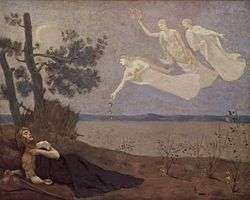Aisling
The aisling (Irish for 'dream, vision', pronounced [ˈaʃlʲɪŋ]), or vision poem, is a poetic genre that developed during the late 17th and 18th centuries in Irish language poetry. The word may have a number of variations in pronunciation, but the 'is' of the first syllable is always realised as a [ʃ] ("sh") sound.

Format
In the aisling, Ireland appears to the poet in a vision in the form of a woman: sometimes young and beautiful, sometimes old and haggard. This female figure is generally referred to in the poems as a Spéirbhean (heavenly woman; pronounced [ˈspʲeːɾʲ.vʲanˠ]). She laments the current state of the Irish people and predicts an imminent revival of their fortunes, usually linked to the return of the Roman Catholic House of Stuart to the thrones of Britain and Ireland.
The form developed out of an earlier, non-political genre akin to the French reverdie, in which the poet meets a beautiful, supernatural woman who symbolises the spring season, the bounty of nature, and love.
The first[1] of the aisling poets was Aodhagán Ó Rathaille, "athair na haislinge" ('father of the aisling'). In his hands, the aisling is a powerful mode of political writing. Also famed for his works in the genre is Eoghan Rua Ó Súilleabháin.
Among the most famous examples of Aisling poetry are Gile na gile by Ó Rathaille and Ceo draíochta i gcoim oíche by Ó Súilleabháin.
Satire
In 1751, Scottish Jacobite poet Alasdair MacMhaighstir Alasdair poked fun at the aisling genre in his Anti-Campbell polemic An Airce ("The Ark").
During the 1780s, Munster poet Brian Merriman also parodied the Aisling genre in his comic masterpiece Cúirt An Mheán Oíche ("The Midnight Court").
Other uses
- LÉ Aisling (P23) is a ship which was in the Irish Naval Service from 1980 to 2016.
- "Aisling" is a poem by Seamus Heaney from the collection North (1975).
- An Aisling poem called ‘We Saw A Vision’ was read out in Irish, during the Queen Elizabeth II 2011 official state visit, at a wreath laying ceremony at the Garden of Remembrance, it is written on the stone wall of the monument in Irish, French, and English.
- The acclaimed Irish author Ciaran Carson has said that much of his literature is based around the idea of the aisling, or dream vision.
- "Aisling" is a poem by Paul Muldoon from his 1983 collection Quoof.
- In the 2009 film 'The Secret of Kells', one main character is a forest fairy called 'Aisling' and her cat is called Pangur Bán.
- Aisling Ghéar by Breandán Ó Buachalla, a 20th century Aisling poet.
- Cathleen ni Houlihan, was based on the Gaelic Aisling but adapted into a theatrical written play by leading members of the Irish Literary Revival movement in 1902. Cathleen Ni Houlihan is an Old poor woman, a seemingly otherworldly figure that is the embodiment of Irish Nationalism, she can only be transformed back into a young woman after a young man gives his life for her Sake. She also symbolically represents the old Celtic mythical tradition of the goddesses of war and Sovereignty.[2]
- In his poem Aisling an t-Saighdeir ("The Soldier's Dream"), Scottish Gaelic Bard and World War I veteran Dòmhnall Ruadh Chorùna recalls seeing a full grown red deer stag in the rush-covered glens north of Locheport and how he scrambled over rocks and banks trying to get a clear shot at the animal. Dòmhnall slowly took aim and ignited the gunpowder with a spark, only to find that the stag was gone. He had been replaced by Dòmhnall's Captain shouting retreat, as the Imperial German Army had swept behind the Cameron Highlanders and were about to cut off all opportunity to escape. Dòmhnall recalled that he had awakened not a moment too soon and that he barely escaped "the net" before the Germans "pulled it together." Some members of his unit, however, were not so lucky and were taken away to POW camps in the German Empire.[3]
- Lady Hazel Lavery posed for portrait personification depictions of a number of literary Aisling figures in Irish history such as James Clarence Mangan’s Dark Rosaleen and W.B.Yeat’s Cathleen Ni Houlihan. The portraits where painted by her husband Sir John Lavery and appeared on bank notes in numerous forms during the course the 20th century in Ireland, they were commissioned by the Irish Free State.
- Some believe the tune of Danny Boy is based on the ancient song of Aisling an Oigfear, the lyrics of Danny boy resemble the viewpoint of a message from a Mother to a Son, the son she had to let leave and become part of the Irish diaspora. The maternal lyric's in the song being a metaphor for Ireland and the land they left behind them.
See also
- Aisling (given name) – includes a list of people with this name
References
- Connolly, S.J. "Literature in Irish". Oxford Companion to Irish History (2nd ed.).
- A Poets’ revolt: How culture heavily influenced the Rising and its leaders, PJ Mathews, January 21 2016, Irish Independent
- Domhnall Ruadh Choruna (1995), page 42-43.